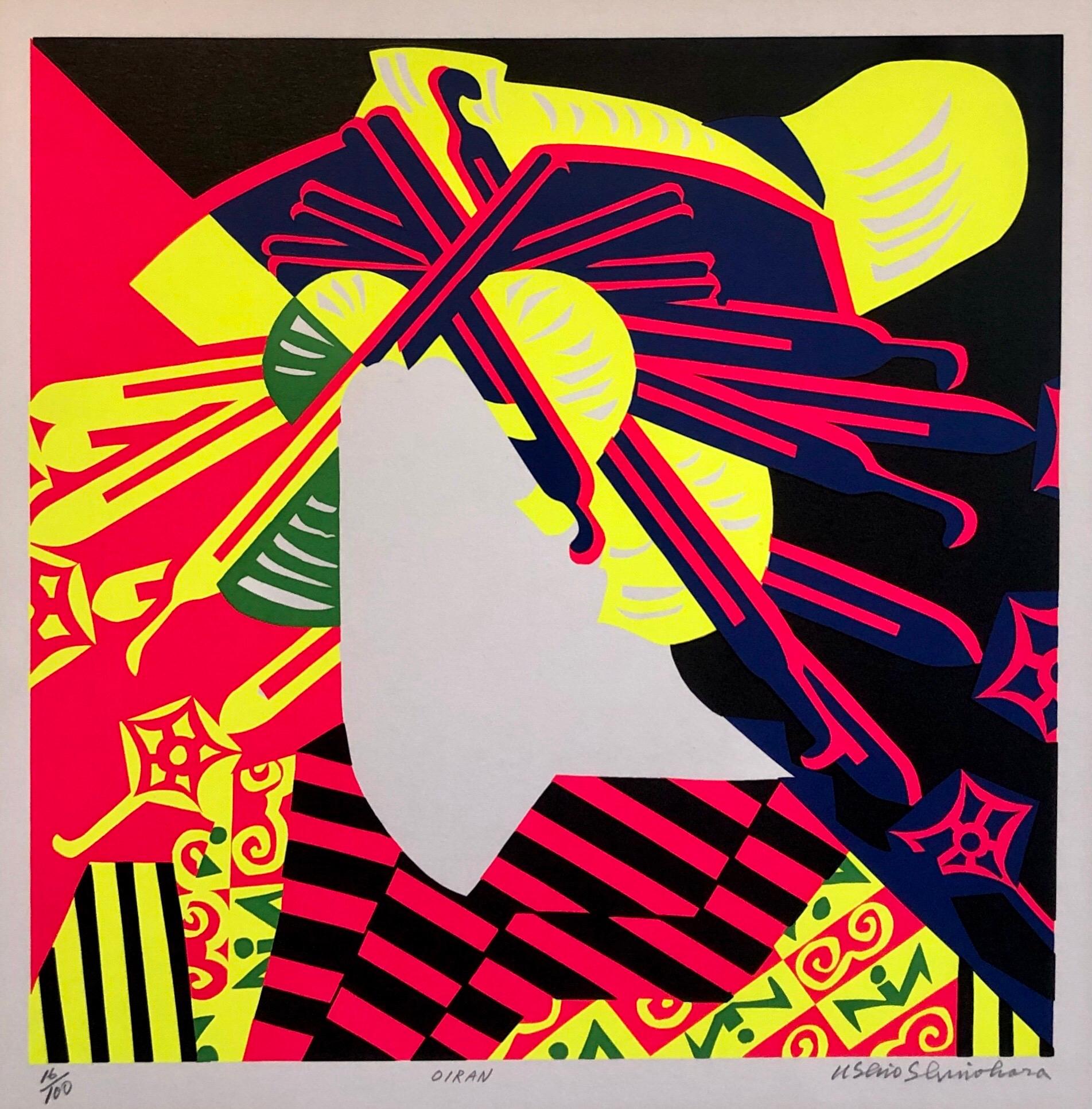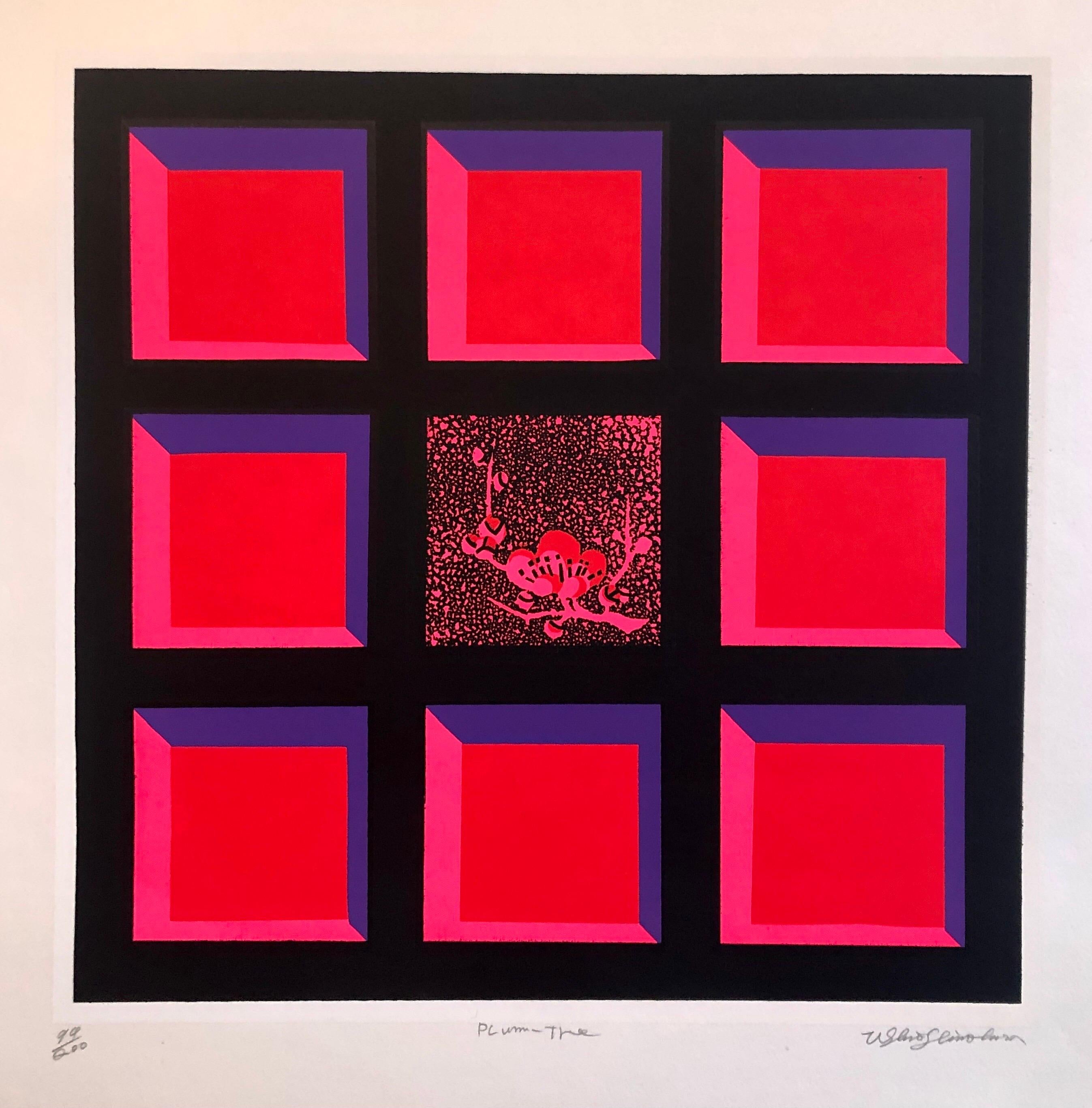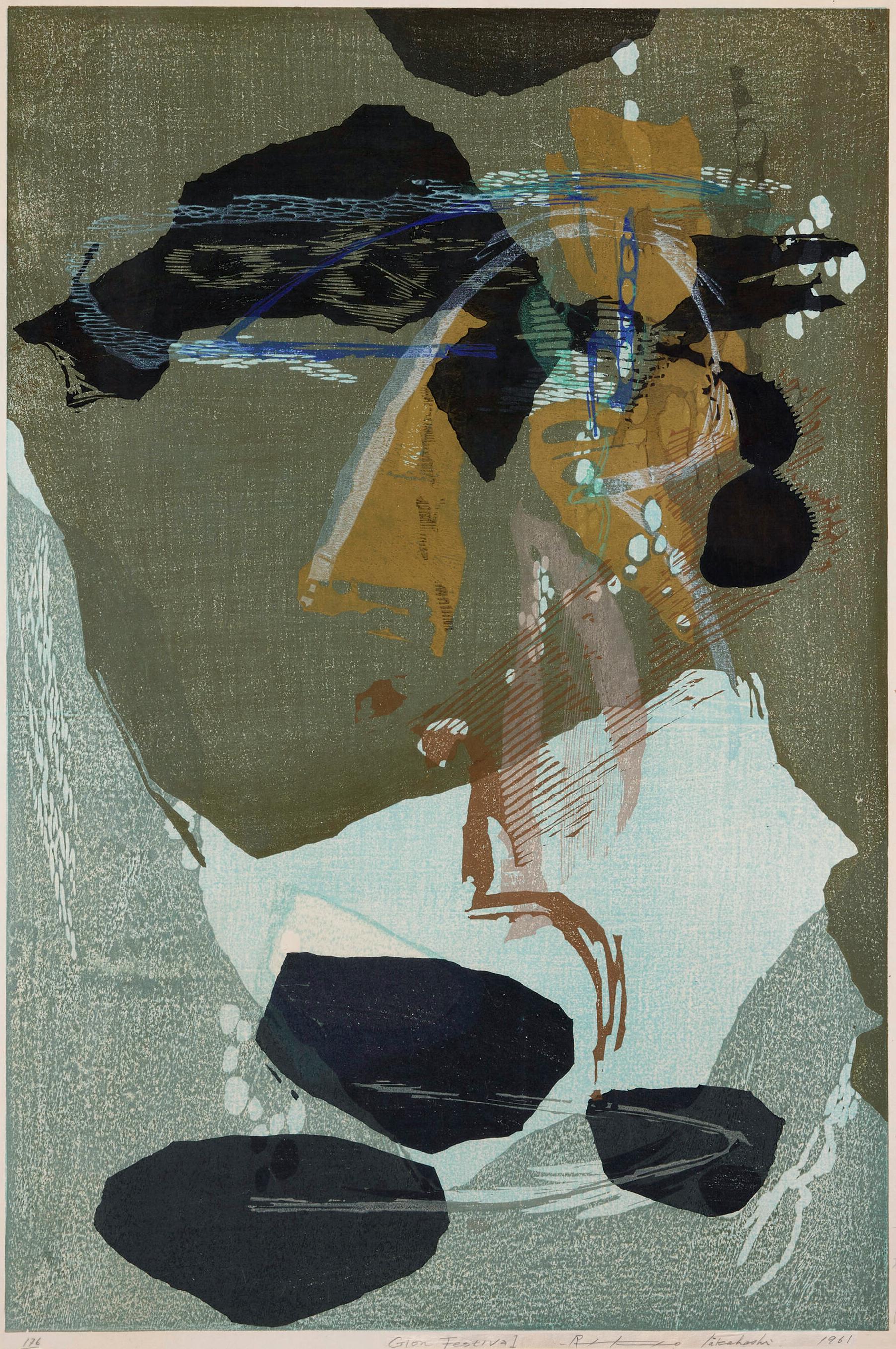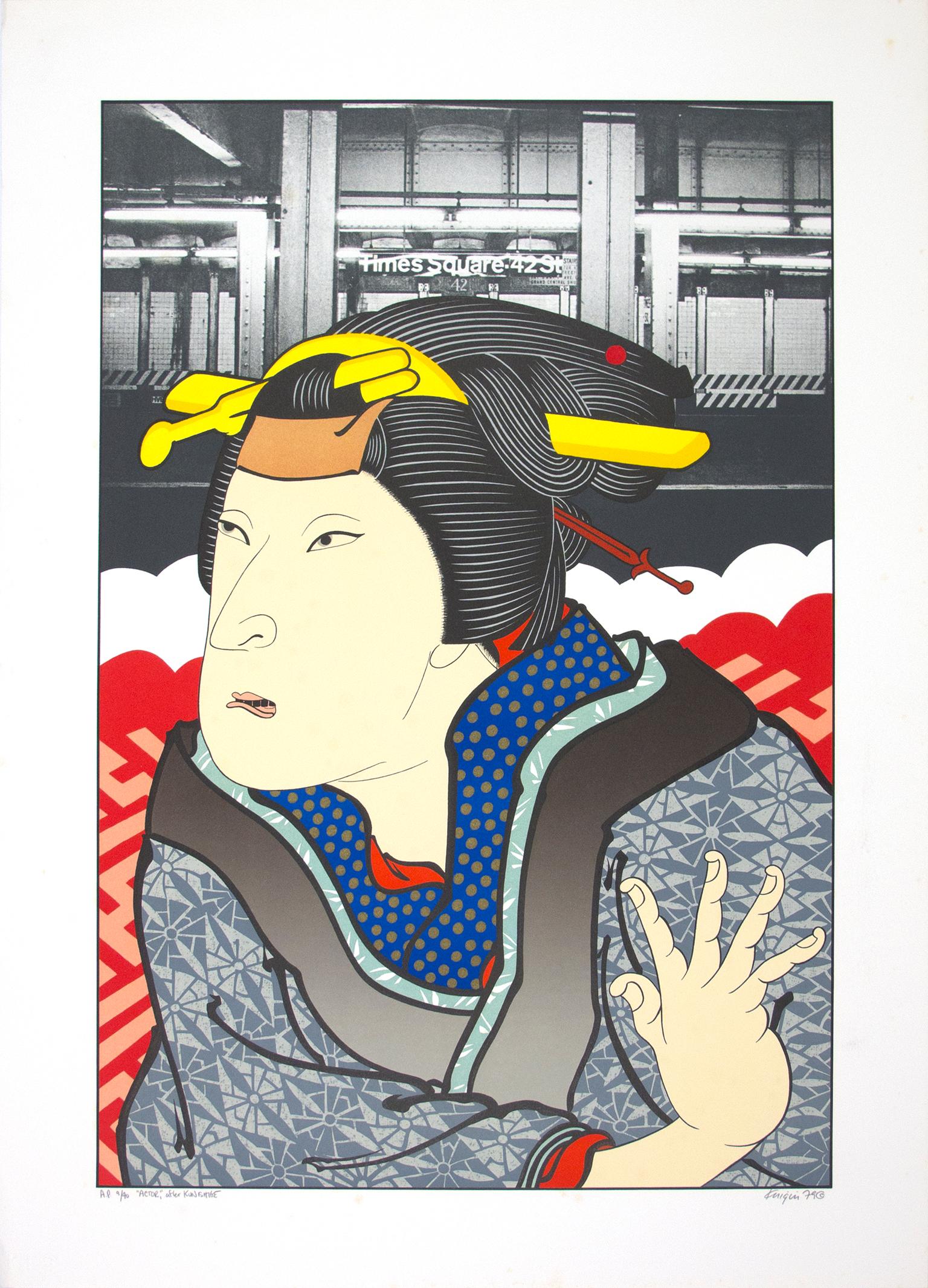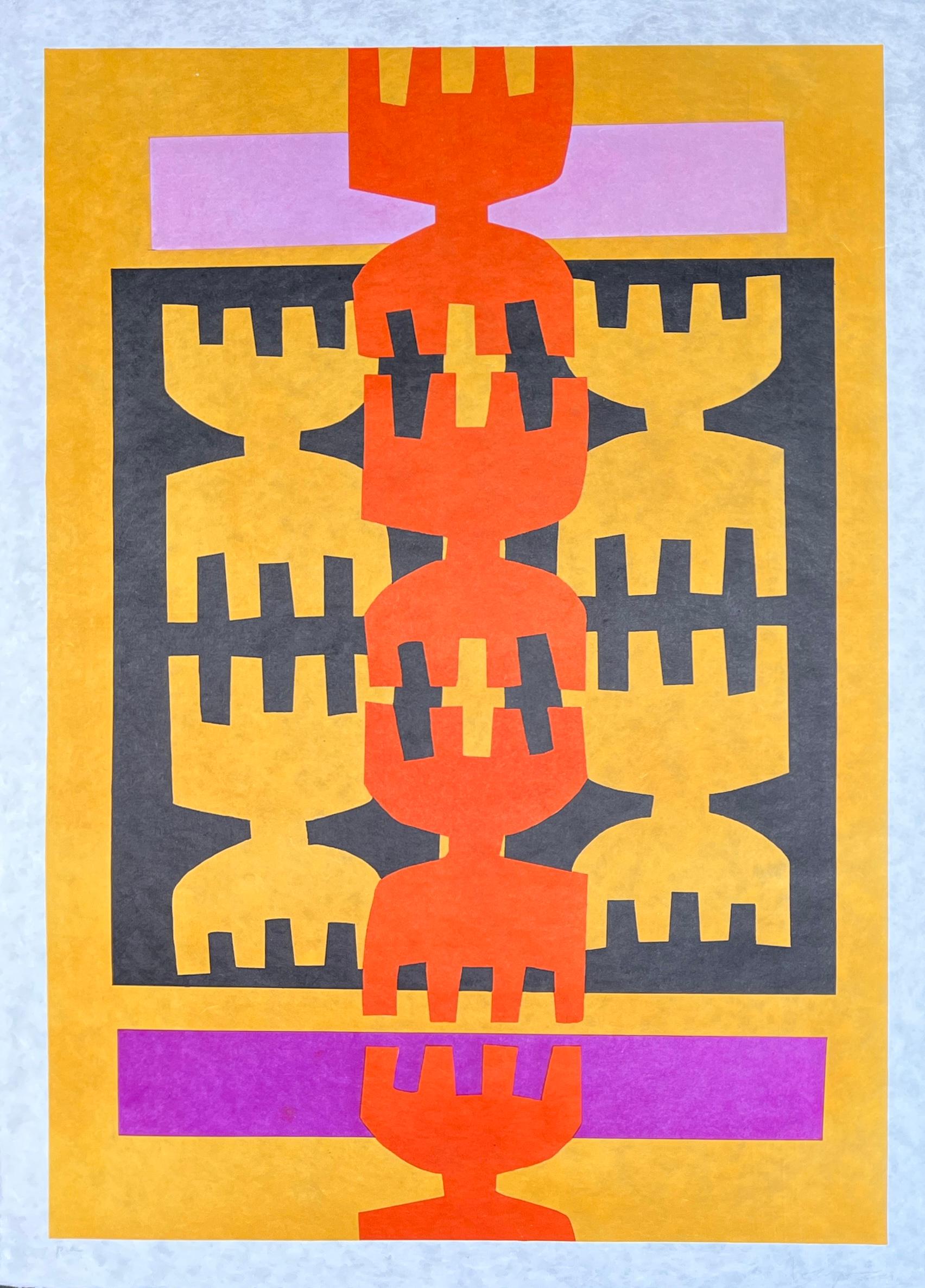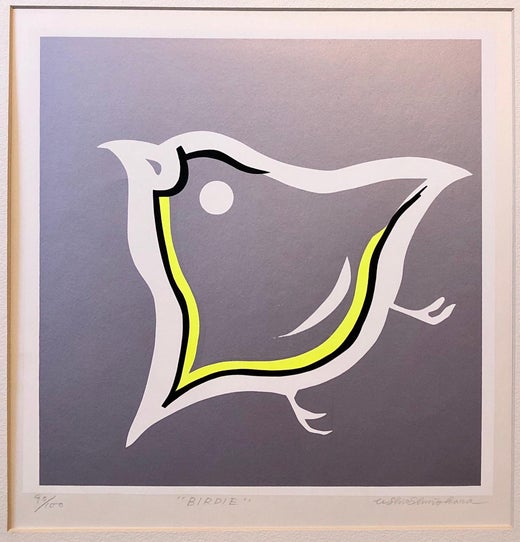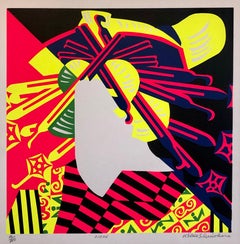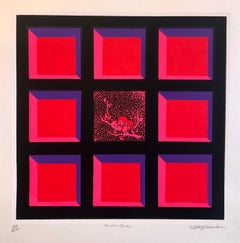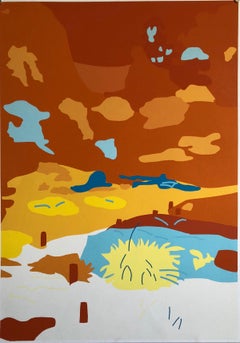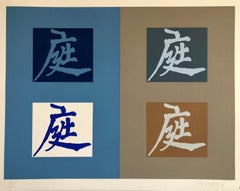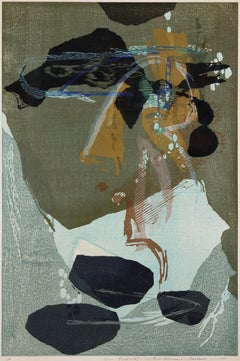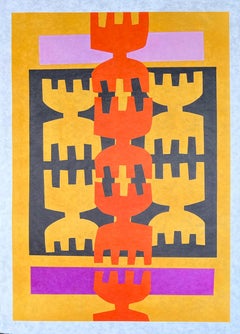Items Similar to Silkscreen Day Glo Fluorescent 1960's Japanese Pop Art Print Samurai Kimono
Want more images or videos?
Request additional images or videos from the seller
1 of 14
Ushio ShinoharaSilkscreen Day Glo Fluorescent 1960's Japanese Pop Art Print Samurai Kimonoc.1969
c.1969
$2,200
£1,670.95
€1,930.50
CA$3,083.38
A$3,450.88
CHF 1,801.09
MX$42,082.97
NOK 23,051.56
SEK 21,821.26
DKK 14,407.10
Shipping
Retrieving quote...The 1stDibs Promise:
Authenticity Guarantee,
Money-Back Guarantee,
24-Hour Cancellation
About the Item
Ushio Shinohara (born 1932, Tokyo), nicknamed “Gyu-chan”, is a Japanese Neo-Dadaist artist. His bright, large work has been exhibited internationally at institutions including the Hara Museum of Contemporary Art, Centre Georges Pompidou, the Guggenheim Museum SoHo, National Museum of Modern Art, Tokyo, Leo Castelli Gallery, New York, Museum of Contemporary Art, Los Angeles and The Metropolitan Museum of Art, Seoul and others. Shinohara and his wife, Noriko, are the subjects of a documentary film by Zachary Heinzerling called Cutie and the Boxer (2013).
Shinohara's parents instilled in him a love for painters such as Paul Cézanne, Vincent Van Gogh and Paul Gauguin. His father was a tanka poet who was taught by Wakayama Bokusui. Shinohara’s mother was a painter who went to the Woman’s Art University (Joshibijutsu Daigaku) in Tokyo.
In 1952 Shinohara entered the Tokyo Art University (later renamed to Tokyo University of the Arts), majoring in oil painting, however he left before graduation in 1957.
In 1960 Shinohara participated in a group called "Neo-Dada Organizers". (Masunobu Yoshimura, Genpei Akasegawa, Shusaku Arakawa, Ushio Shinohara, Sho Kazakura, Tomio Miki, Tetsumi Kudo, Natsuyuki Nakanishi) This group of artists showed their works of art in an exhibition in the 1960s called the Yomiuri Independent Exhibition. This exhibition was sponsored by a newspaper, was open to the public, and was not judged by anyone. This type of exhibition was a form of an anti-salon and was a stepping stone for Shinohara’s sculptures of found objects which acquired the label of “junk art.” Later, while living in New York, to save money on canvases (which were and are expensive) Ushio would wander alleyways collecting scraps of cardboard which he would bring back to his studio, wash, and then use to create his sculptures (so-called "junk art") composed of other found objects including discarded trash, motorcycle parts, and other mass-produced tokens of modern society.
The Neo Dadaism Organizers, including fellow Yomiuri Independent Exhibition participants Akasegawa Genpei, Shusaku Arakawa, and Yoshimura Masanobu, eventually transitioned into the Neo-Dada movement. The Neo-Dada movement can be considered a phase into Pop Art and was influenced by many of the avant-garde artists. The art that was crafted during the Neo-Dada movement was made with everyday items. (An artist who was influenced by Neo-Dadaism was Andy Warhol.)
During this time Shinohara created work called “boxing paintings” in which the artist dipped boxing gloves in sumi ink or paint and punched paper or canvas to splatter it with pigment.
Shinohara, similar to many action-painting oriented artists of the 1950s and 1960s, cared more for the gesture and vitality and less for the beauty of the image. As Julia Cassim observed in her 1993 review of Shinohara's retrospective at Tsukashin Hall in Amagasaki, Japan, “His kaleidoscopic paintings of pneumatic, rubber-nippled nudes, bikers and Coney Island’s garish glories are painted in the acid reds, greens and pinks common to Asian street fairs from Tokyo to Bombay. They burst at the seams with detail. Seemingly slapdash and rapidly painted, they are, in fact, as carefully composed as any more formal work.”
By 1965 the Neo-Dada Organizers group gave way and Shinohara left for New York in 1969 with a grant from the John D. Rockefeller 3rd Fund To visit New York was Shinohara’s dream; he left with the intention of staying in New York for a short period to work and create new ideas because of the different surroundings. He came to love the city's spirit and the mix of ethnicities so much he decided not to return to Japan. In New York he loved being a tourist and getting inspiration from anything and anyone he ran into. He kept with the concept of reinventing American art such as comics and Neo-Dada works. In 1965, before Shinohara left for New York, he started one of his most successful series of works is called "Oiran". An oiran is a title given to a courtesan. Instead of making his work look beautiful to represent what an oiran's personality was like, he made her look ugly and based this work off work in the Edo period (1603–1868). This period can, in a way, be called the beginning of the modern period of Japan. The "Oiran" work was a backlash or rejection of what society believed to be beautiful. He used fluorescent paint and showed the grotesque beauty that was ignored many times in Japanese art. Kimono detail. For the "Oiran Series", Shinohara was awarded a prize by the William and Norma Copley Foundation.His next works of art became motorcycles done around 1970. In his mind, motorcycles represented America. He created these works out of discarded objects — primarily scraps of cardboard he washed and soaked in water to make them pliant, shaping them almost like papier-mâché. They were rough, vigorous sculptures. The motorcycles were reminiscent of what America meant to him, but many times these sculptures had geishas riding on the back seat. The sculptures were painted in shades of green, pink and red which paralleled the colors of street fairs in Tokyo. They were full of detail, very carefully composed, and extremely large. Shinohara wanted these pieces to have a great effect on the viewer and sought to accomplish that with the composition, vivid colors and the scale of the work. Around 1990, he turned to boxing-painting once more using a huge piece of paper and boxing gloves dipped into neon paint. This art was soon turned into a performance. He turned these performances into "battles" where he battles against other artists before a crowd, usually in New York.
Photographer Shōmei Tōmatsu was a strong influences on his art. Shomei Tomatsu was a Japanese photographer who studied at Aichi University. He took photos for Japanese photography magazines that were controversial and showed contemporary images. Shinohara was also influenced by Hollywood culture, comic books and the culture of jazz.
Ushio Shinohara has been married to artist Noriko Shinohara since the early 1970s, together they have a son who is also an artist, Alexander Kūkai Shinohara. Their tumultuous life together as a family was subject to the Zachary Heinzerling directed, 2013 documentary, Cutie and the Boxer. The family is based in the Dumbo neighborhood of Brooklyn, New York. Ushio Shinohara had a previous marriage in Japan and has two children from that marriage.
In 1982, the Japan Society in New York City hosted an exhibition of Shinohara's work, titled "Tokyo Bazooka". It was curator Alexandra Munroe's first project at the museum after having studied Japanese art through the mid-19th century and reportedly inspired her research into modern and contemporary Japanese artists practice, including the 1994 exhibition and catalogue "Japanese Art After 1945: Scream Against the Sky".
In 1990, Ushio Shinohara's work was part of a traveling exhibition that was sponsored by the Museum of Modern Art in New York. Also, his boxing-painting and motorcycle sculptures were a part of an exhibition at MoMA from September through November 2005. Shinohara's work "Coca-Cola Plan" (1964) was included in "Tokyo 1955–1970: A New Avant-Garde" with ran from November 2012 until February 2013 at the MoMA in New York.
Collections
Shinohara's work is found in multiple public museum collections including: Museum of Modern Art (MoMA) New York, the Metropolitan Museum of Art, Hara Museum of Contemporary Art, Hyogo Prefectural Museum of Art with the Yamamura Collection, and others.
A 1961 photograph by William Klein, of Shinohara creating a boxing painting performance is included in the collection at Museum of Fine Arts, Houston.
- Creator:Ushio Shinohara (1932, Japanese)
- Creation Year:c.1969
- Dimensions:Height: 17 in (43.18 cm)Width: 22 in (55.88 cm)
- Medium:
- Movement & Style:
- Period:
- Condition:light toning where it was matted. please se photos.
- Gallery Location:Surfside, FL
- Reference Number:1stDibs: LU38215643942
Ushio Shinohara
Ushio Shinohara, nicknamed Gyu-chan, is a Japanese Neo-Dadaist artist. His bright, large work has been exhibited internationally at institutions including the Hara Museum of Contemporary Art, Centre Georges Pompidou, the Guggenheim Museum SoHo, National Museum of Modern Art, Tokyo, Leo Castelli Gallery, New York, Museum of Contemporary Art, Los Angeles and The Metropolitan Museum of Art, Seoul, The Tate Modern- World Goes Pop Exhibition. Shinohara and his wife, Noriko, are the objects of a documentary film by Zachary Heinzerling called Cutie and the Boxer (2013).
About the Seller
4.9
Platinum Seller
Premium sellers with a 4.7+ rating and 24-hour response times
Established in 1995
1stDibs seller since 2014
1,782 sales on 1stDibs
Typical response time: <1 hour
- ShippingRetrieving quote...Shipping from: Surfside, FL
- Return Policy
Authenticity Guarantee
In the unlikely event there’s an issue with an item’s authenticity, contact us within 1 year for a full refund. DetailsMoney-Back Guarantee
If your item is not as described, is damaged in transit, or does not arrive, contact us within 7 days for a full refund. Details24-Hour Cancellation
You have a 24-hour grace period in which to reconsider your purchase, with no questions asked.Vetted Professional Sellers
Our world-class sellers must adhere to strict standards for service and quality, maintaining the integrity of our listings.Price-Match Guarantee
If you find that a seller listed the same item for a lower price elsewhere, we’ll match it.Trusted Global Delivery
Our best-in-class carrier network provides specialized shipping options worldwide, including custom delivery.More From This Seller
View AllSilkscreen Oiran Day Glo Fluorescent 1960's Japanese Pop Art Print Geisha Kimono
By Ushio Shinohara
Located in Surfside, FL
Ushio Shinohara (born 1932, Tokyo), nicknamed “Gyu-chan”, is a Japanese Neo-Dadaist artist. His bright, large work has been exhibited internationally at institutions including the Hara Museum of Contemporary Art, Centre Georges Pompidou, the Guggenheim Museum SoHo, National Museum of Modern Art, Tokyo, Leo Castelli Gallery, New York, Museum of Contemporary Art, Los Angeles and The Metropolitan Museum of Art, Seoul and others. Shinohara and his wife, Noriko, are the subjects of a documentary film by Zachary Heinzerling called Cutie and the Boxer (2013).
Shinohara's parents instilled in him a love for painters such as Paul Cézanne, Vincent Van Gogh and Paul Gauguin. His father was a tanka poet who was taught by Wakayama Bokusui. Shinohara’s mother was a painter who went to the Woman’s Art University (Joshibijutsu Daigaku) in Tokyo.
In 1952 Shinohara entered the Tokyo Art University (later renamed to Tokyo University of the Arts), majoring in oil painting, however he left before graduation in 1957.
In 1960 Shinohara participated in a group called "Neo-Dada Organizers". (Masunobu Yoshimura, Genpei Akasegawa, Shusaku Arakawa, Ushio Shinohara, Sho Kazakura, Tomio Miki, Tetsumi Kudo...
Category
1960s Pop Art Abstract Prints
Materials
Screen
Silkscreen Day Glo Fluorescent Japanese Gyu-chan Neo Dada Print Plum Tree Litho
By Ushio Shinohara
Located in Surfside, FL
Ushio Shinohara (born 1932, Tokyo), nicknamed “Gyu-chan”, is a Japanese Neo-Dadaist artist. His bright, large work has been exhibited internationally at institutions including the Hara Museum of Contemporary Art, Centre Georges Pompidou, the Guggenheim Museum SoHo, National Museum of Modern Art, Tokyo, Leo Castelli Gallery, New York, Museum of Contemporary Art, Los Angeles and The Metropolitan Museum of Art, Seoul and others. Shinohara and his wife, Noriko, are the subjects of a documentary film by Zachary Heinzerling called Cutie and the Boxer (2013).
Shinohara's parents instilled in him a love for painters such as Paul Cézanne, Vincent Van Gogh and Paul Gauguin. His father was a tanka poet who was taught by Wakayama Bokusui. Shinohara’s mother was a painter who went to the Woman’s Art University (Joshibijutsu Daigaku) in Tokyo.
In 1952 Shinohara entered the Tokyo Art University (later renamed to Tokyo University of the Arts), majoring in oil painting, however he left before graduation in 1957.
In 1960 Shinohara participated in a group called "Neo-Dada Organizers". (Masunobu Yoshimura, Genpei Akasegawa, Shusaku Arakawa, Ushio Shinohara, Sho Kazakura, Tomio Miki, Tetsumi Kudo...
Category
1960s Pop Art Abstract Prints
Materials
Screen
Large Abstract Vibrant Colorful Silkscreen Serigraph Print Japanese Garden
By Tom Baldwin
Located in Surfside, FL
Recently graduated from Pasadena’s legendary Art Center College of Design, Tom Baldwin created the series of inkjet prints Japanese Gardens in 1996 on his computer, using then-nascen...
Category
1990s Abstract Abstract Prints
Materials
Inkjet, Screen
1980's Large Silkscreen Chinese Characters Serigraph Pop Art Print China
By Chryssa Vardea-Mavromichali
Located in Surfside, FL
Chryssa Vardea-Mavromichali (Greek: Χρύσα Βαρδέα-Μαυρομιχάλη; December 31, 1933 – December 23, 2013) was a Greek American artist who worked in a wide variety of media. An American art pioneer in light art and luminist sculpture widely known for her neon, steel, aluminum and acrylic glass installations, she has always used the mononym Chryssa professionally. She worked from the mid-1950s in New York City studios and worked since 1992 in the studio she established in Neos Kosmos, Athens, Greece.
Chryssa was born in Athens into the famous Mavromichalis family from the Mani Peninsula. one of her sisters, who studied medicine, was a friend of the poet and novelist Nikos Kazantzakis.
Chryssa began painting during her teenage years and also studied to be a social worker.In 1953, on the advice of a Greek art critic, her family sent her to Paris to study at the Académie de la Grande Chaumiere where Andre Breton, Edgard Varese, and Max Ernst were among her associates and Alberto Giacometti was a visiting professor.
In 1954, at age twenty-one, Chryssa sailed for the United States, arrived in New York and went to San Francisco, California to study at the California School of Fine Arts. Returning to New York in 1955, she became a United States citizen and established a studio in the city.
Chryssa's first major work was The Cycladic Books preceded American minimalism by seventeen years.
1961, Chryssa's first solo exhibition was mounted at The Guggenheim.
1963, Chryssa's work was shown at the Museum of Modern Art in curator Dorothy Canning Miller's Americans 1963 exhibition. The artists represented in the show also included Richard Anuszkiewicz, Lee Bontecou, Robert Indiana, Richard Lindner, Marisol, Claes Oldenburg, Ad Reinhardt, James Rosenquist and others.
1966, The Gates to Times Square, regarded as "one of the most important American sculptures of all time" and "a thrilling homage to the living American culture of advertising and mass communications." The work is a 10 ft cube installation of two huge letter 'A's through which visitors may walk into "a gleaming block of stainless steel and Plexiglas that seems to quiver in the play of pale blue neon light" which is controlled by programmed timers. First shown in Manhattan's Pace Gallery, it was given to the Albright-Knox Art Gallery in Buffalo, New York in 1972.
1972, The Whitney Museum of American Art mounted a solo exhibition of works by Chryssa.
That's All (early 1970s), the central panel of a triptych related to The Gates of Times Square, was acquired by the Museum of Modern Art between 1975 and 1979.
1973, Chryssa's solo exhibition at the Gallerie Denise René was reviewed for TIME magazine by art critic Robert Hughes before it went on to the Galleries Denise René in Düsseldorf and Paris.
Other works by Chryssa in composite honeycomb aluminum and neon in the 1980s and 1990s include Chinatown, Siren, Urban Traffic, and Flapping Birds.
Chryssa 60/90 retrospective exhibition in Athens in the Mihalarias Art Center. After her long absence from Greece, a major exhibition including large aluminum sculptures - cityscapes, "neon boxes" from the Gates to the Times Square, paintings, drawings etc. was held in Athens.
In 1992, after closing her SoHo studio, which art dealer Leo Castelli had described as "one of the loveliest in the world," Chryssa returned to Greece. She found a derelict cinema which had become a storeroom stacked with abandoned school desks and chairs, behind the old Fix Brewery near the city center in Neos Kosmos, Athens. Using the desks to construct enormous benches, she converted the space into a studio for working on designs and aluminum composite honeycomb sculptures. The Athens National Museum of Contemporary Art, which was founded in 2000 and owns Chryssa's Cycladic Books, is in the process of converting the Fix Brewery into its permanent premises.
Greek Exhibits, European Cultural Center of Delphi (Council of Europe). "Apollo's Heritage"(July 4, 2003 – July 30, 2003). Works by sixteen artists: Giorgio de Chirico, Salvador Dalí, Nikos Hadjikyriakos-Ghikas, Nikos Engonopoulos, Yannis Tsarouchis, Giorgos Sikeliotis, Takis, Arman, Fernando Botero, Chryssa, Dimitris Mytaras...
Category
1980s Pop Art Abstract Prints
Materials
Screen
Bold Abstract Latin American Screenprint Scarf Textile Art Print Josep Guinovart
By Josep Guinovart Bertrán
Located in Surfside, FL
This is a thin cotton (that is my best estimate. it does not feel like silk) scarf, woven textile, fabric piece. It is signed in the print and hand numbered.
Josep Guinovart (1927 ...
Category
20th Century Abstract Abstract Prints
Materials
Textile
Silkscreen Day Glo Fluorescent Japanese Gyu-chan Neo Dada Art Print Birdie Litho
By Ushio Shinohara
Located in Surfside, FL
19 x 15.5 with backing 12 x 12 image
Ushio Shinohara (born 1932, Tokyo), nicknamed “Gyu-chan”, is a Japanese Neo-Dadaist artist. His bright, large work has been exhibited internationally at institutions including the Hara Museum of Contemporary Art, Centre Georges Pompidou, the Guggenheim Museum SoHo, National Museum of Modern Art, Tokyo, Leo Castelli Gallery, New York, Museum of Contemporary Art, Los Angeles and The Metropolitan Museum of Art, Seoul and others. Shinohara and his wife, Noriko, are the subjects of a documentary film by Zachary Heinzerling called Cutie and the Boxer (2013).
Shinohara's parents instilled in him a love for painters such as Paul Cézanne, Vincent Van Gogh and Paul Gauguin. His father was a tanka poet who was taught by Wakayama Bokusui. Shinohara’s mother was a painter who went to the Woman’s Art University (Joshibijutsu Daigaku) in Tokyo.
In 1952 Shinohara entered the Tokyo Art University (later renamed to Tokyo University of the Arts), majoring in oil painting, however he left before graduation in 1957.
In 1960 Shinohara participated in a group called "Neo-Dada Organizers". (Masunobu Yoshimura, Genpei Akasegawa, Shusaku Arakawa, Ushio Shinohara, Sho Kazakura, Tomio Miki, Tetsumi Kudo...
Category
1960s Pop Art Abstract Prints
Materials
Screen
You May Also Like
Samurai, Abstract Screenprint by Arman
By Arman
Located in Long Island City, NY
Artist: Arman, French (1929 - 2005)
Title: Samurai
Year: circa 1980
Medium: Serigraph, signed and numbered in pencil
Edition: 150, AP 30
Size: 30 in. x 22 in. (76.2 cm x 55.88 ...
Category
1980s Dada Figurative Prints
Materials
Screen
“Gion Festival” 1961 woodcut RIKIO TAKAHASHI Japanese sōsaku hanga artist
By Rikio Takahashi
Located in Rancho Santa Fe, CA
Woodcut in colors
Image size: H 33 x W 22 in.
Sight size: H 33.5 x W 22 in.
Numbered, titled, signed, and dated lower edge
This work can be viewed at our New York City showroom by a...
Category
1960s Abstract Abstract Prints
Materials
Woodcut, Paper
"Actor, After Kunishige" Original Lithograph japan pop art figure bright signed
By Michael Knigin
Located in Milwaukee, WI
"Actor, After Kunishige" is an original color lithograph by Michael Knigin. The artist signed the piece lower right and titled it lower left. This piece features a figure in a tradit...
Category
1970s Pop Art Figurative Prints
Materials
Lithograph, Ink
Giuseppe Capogrossi (1900-1972) - Lithograph on Japanese paper - 1970
By Giuseppe Capogrossi
Located in Varese, IT
Quarzo N° 4
Rare deluxe issue lithograph printed on extremely fine Japanese paper, edited in 1970.
Limited edition of 15 copies on Japanese paper and some artist's proofs, numbered ...
Category
1970s Pop Art Abstract Prints
Materials
Paper
Untitled - Original Screen Print by Wladimiro Tulli - 1970s
By Wladimiro Tulli
Located in Roma, IT
Untitled is a colored serigraph on paper, realized by the Italian artist, Wladimiro Tulli.
Hand-signed and numbered in pencil on lower margin. Edition of 99 prints.
This contempor...
Category
1970s Abstract Abstract Prints
Materials
Screen
Tantra Abstractions, Pop Art Serigraph by John Grillo
By John Grillo
Located in Long Island City, NY
Artist: John Grillo, American (1917 - 2014)
Title: Tantra Abstractions
Year: 1980
Medium: Serigraph, signed and numbered in pencil
Edition: 200, AP 30
Image Size: 30 x 22 inches...
Category
1980s Pop Art Abstract Prints
Materials
Screen
